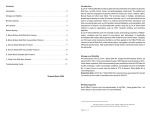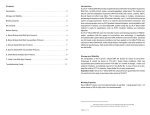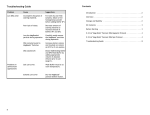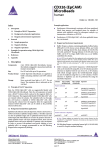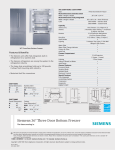Download Troubleshooting Guide Contents
Transcript
Contents Troubleshooting Guide Likely Cause Suggestions Low DNA yield Incomplete resuspension of magnetic particle Resuspend the magnetic particles by vortexing before use. Frozen Tissue samples not mixed properly after thawing. Thaw the frozen Tissue at room temperature an d gently mix the Tissue by inverting. Loss the MagBind® particle during operation Carefully avoid remove the MagBind® particles during aspiration E-Z 96® Mag-Binds® Cultured Cell Protocol . . . . . . . . . . . . . . . . . . . . . . . 8 DNA remains bound to MagBind®Particles Increase elution volume and incubate at 65oC for 5 min elution. Pipet up and down for 50-100 times. E-Z 96® Mag-Binds® Baccul Swabs Protocol . . . . . . . . . . . . . . . . . . . . . . 11 Ethanol carry-over Dry the Mag-Bind particle before elution. P ro b l e m i n downstream applications 12 Introduction . . . . . . . . . . . . . . . . . . . . . . . . . . . . . . . . . . . . . . . . . . . 2 Problem Overview . . . . . . . . . . . . . . . . . . . . . . . . . . . . . . . . . . . . . . . . . . . . . 2 Storage and Stability . . . . . . . . . . . . . . . . . . . . . . . . . . . . . . . . . . . . . 2 Kit Contents . . . . . . . . . . . . . . . . . . . . . . . . . . . . . . . . . . . . . . . . . . . 3 Before Starting . . . . . . . . . . . . . . . . . . . . . . . . . . . . . . . . . . . . . . . . . 3 E-Z 96® Mag-Binds® Tissue Protocol . . . . . . . . . . . . . . . . . . . . . . . . . . . . 5 E-Z 96® Mag-Binds® Mouse Tail Protocol . . . . . . . . . . . . . . . . . . . . . . . . . 9 Troubleshooting Guide . . . . . . . . . . . . . . . . . . . . . . . . . . . . . . . . . . . 12 E-Z 96® MagSi DNA Tissue DNA Kit for Buccal Swabs The following protocol is designed for isolating DNA from buccal swabs with magnetic beads. Kit Contents Product Number M6229-00 M6229-01 M6229-02 Purification Times 1 x 96 Preps 4 x 96 Preps 20 x 96 Preps 500 :l Micro Plate 1 4 20 1.2ml Process Plate 1 4 20 1. Place the swab into each well of 96 well plate(no provided). 2. Prepare a Proteinase K/Buffer TL working solution by mixing 20 :l Proteinase K with 250:l Buffer TL for each sample. For each 96 sets of sample, prepare the Protease/TL stock working solution by mix 2.0mL protease with 25mL Buffer TL. Pipet 250 :l protease/TL working solution into each well. Seal the plate properly. 8-strip caps 10 x 8 35 x 8 170 x 8 MagSi DNA Particles 2.2 ml 9 ml 45ml Buffer TL 20 ml 90 ml 2 x 180 ml Buffer MSL 20 ml 90 ml 2 x 180 ml Incubate at 56°C for 1 hours. Mix occasionally during the incubation by rotating the plate gently. Make sure the samples are completely lysed. Buffer MP 30 ml 100 ml 8 x 100 ml 2 ml 8 ml 32 ml 3. Proteinase K 4. Spin at 3,000-5,000 x g for 1 minutes at room temperature. RNase A 550 :l 2.1 ml 10 ml 5. Transfer 150 :l of the Sample into each well of Plate (provided). Elution Buffer 100 ml 2 x 200 ml 8 x 250 ml Add 150:l Buffer MSL, 20 :l MagSi DNA Paritcles and 220 :l absolute ethanol to the lysate. Mix the sample by pipetting up and down 20-30 times to mix well or shaking to mix well. Note: Buffer MSL, MagSi DNA Particles and absolute ethanol can be premixed. The mixture can be stored at room temperature for 3 hours. 1 1 1 6. 7. Place the Plate on a magnetic separation device (MSD-01) to magnetize the MagSi DNA particles for 3 min. The liquid should be cleared after all the magnetic beads are pelleted on the corner of the each well adjecent to the magnet. 8. Aspirate and discard the cleared supernatant. 9. Remove the Plate containing the MagSi DNA particles from the magnetic separation device. Add 500:l Buffer MP diluted with ethanol into each well. Note: Buffer MP must be diluted with absolute ethanol (96-100%) before use in this protocol. Instruction Booklet ® 10. Resuspend MagSi DNA particles pellet by pipetting up and down 20 times or shaking to mix well. 10 3 E-Z 96® MagSi DNA Tissue DNA Kit for Cultured cells: E-Z 96® Mag-Bind Tissue DNA Protocol for Tissues This protocol is designed for the rapid isolation of up to 10 ug genomic DNA from up to 1 x 106 cultured cells. Materials to be provided by user: ! Laboratory centrifuge capable of 3,000-5,000 x g equipped with swingingbucket rotor. ! Adapter for deep-well microplate ! Waterbath equilibrated to 56°C and 65oC ! Equilibrated sterile dH2O water or Elution Buffer at 65oC ! Absolute (96%-100%) ethanol ! Multichannel pipet with tips ! E-Z 96 Magnetic Separation Strand (Cat# MSD-01) 1. Prepare a RNase/PBS working solution by mixing 5 :l RNase A with 100:l PBS for each sample. For each 96 sets of sample, prepare the Rnase/PBS stock working solution by mix 0.5 mL RNase with 10 mL PBS. 2. Prepare the cell suspension 2a. Frozen cell samples should be thawed before starting this protocol. Pellet the cells by centrifugation, wash the cells with PBS and resuspend cells with 100:l cold (4NC) PBS/RNase. Proceed with step 2 of this protocol. 2b. For cells grown in suspension, pellet 1 x 106 cells by spinning at 1200 x g. Discard the supernatant and wash the cells once with PBS. Resuspend cells with 100:l cold (4NC) PBS/RNase. 2c. For cells grown in a monolayer, harvest the cell by either using a trypsin treatment or scrape with rubber policemen. Wash cells twice, and resuspend the cells with 100:l cold (4NC) PBS/RNase. 3. Transfer the suspended cells into each well of Process plate. Make a chart to record the position of each sample. 4. Add 20 :l Proteinase K into each well of process plate. mix well by shaking. incubate at room temperature for 10 minutes. 5. 1. Mince 5-10 mg tissues and place into each well of 1.2ml process plate. Make a chart to record the position of each sample. 2. Prepare an Proteinase K/Buffer TL working solution by mixing 20 :l Proteinase K with 130 ul Buffer TL for each sample. For each 96 sets of samples, prepare the Protease/TL stock working solution by mix 2.0 mL protease with 13 mL Buffer TL. Pipet 130 :l protease/TL working solution into each well. Seal the plate properly using the caps supplied. 3. Mix the samples by inverting the plate 3-5 times. Briefly spin the plate at 2,500-3,000 x g to collect any residue solution from the caps. It is very important that samples are completely submerged in the solution. 4. Incubate at 56°C overnight or until the samples are completely lysed. The lysate should be clear and viscous after digestion is complete. Mix occasionally during the incubation by rotating the plate gently. Make sure the samples are completely lysed. 5. Shake or vortex the plate vigorously from side to side. (Do not shake up and down to avoid leaking around the caps.) Ensure the lysate is completely homogenous after shaking. If a gelatinous mass is visible, further digestion is required. Add 100 :l Buffer MSL into each well of Process plate. Seal the plate properly using the caps supplied. Incubate at 65oC for 15 min. 6. Add 20 :l MagSi DNA Particles and 160:l absolute ethanol into each well of process plate. Mix the sample by pipetting up and down 20-30 times to mix well or shaking to mix well. 7. Following steps 8-24 at pate 6-7. 8 OPTIONAL: Although no mechanical homogenization of tissue is necessary, pulverizing the samples in liquid nitrogen will improve lysis and reduce incubation time. Once the liquid nitrogen has evaporated, transfer the powdered tissue to a clean Racked Microtubes. Add 130 :l Buffer TL/Proteinase K and proceed to step 3 below. 5 Introduction The E-Z 96® Mag-Bind® Tissue DNA Kit provides a rapid and easy method for the isolation of genomic DNA for consistent PCR and Southern analysis. Up to 10 mg tissue or up to 1 cm sections of mouse tail can be readily processed in one time. The method can also be used for preparation of genomic DNA from mouse tail snips, blood, buffy coat, serum, and plasma. The kit allows single or multiple, simultaneous processing of samples. There is no need for phenol/chloroform extractions and time-consuming steps such as precipitation with isopropanol or ethanol are eliminated. The Kit allows single or multiple simultaneous processing of samples in under 1 hours. DNA purified using The E-Z 96® Mag-Binds® Tissue DNA Kit is ready for applications such as PCR, Southern blotting and restriction digestion. 11. Place the plate onto a magnetic separation device to magnetize the MagSi DNA particles for 3 min. Remove and discard the cleared supernatant. 12. Remove the plate from the magnetic separation device. Add 500:l of 70% ethanol and pellet by pipetting up and down 5 times or shaking to mix well. 13. Place the plate onto a magnetic separation device to magnetize the MagSi DNA particles for 3 min. Remove and discard the cleared supernatant. 14. Aspirate and discard the cleared supernatant. 15. Remove the plate from the magnetic separation device. Add 500:l of 70% ethanol into the plate and pellet by pipetting up and down 5 times or shaking to mix well. 16. Place the plate onto a magnetic separation device to magnetize the MagSi DNA particles for 3 min. Remove and discard the cleared supernatant. Overview 17. Remove and discard the cleared supernatant. If using the E-Z 96® Mag-Binds® Tissue DNA Kit for the first time, please read this booklet in its entirety to become familiar with the procedures. Tissue samples lysed in a specially formulated buffer. The binding conditions are adjusted so that genomic DNA will selectively bind to the Mag-Binds® particles. Two rapid wash steps remove trace contaminants such as residual polysaccharides, and pure DNA is eluted in Elution Buffer. Purified DNA can be directly used in downstream applications without the need for further purification. 18. Do not remove the plate from the magnetic separation device. Add 500:l Elution Buffer into the plate. incubate for 30 seconds. Remove and discard the cleared supernatant. 19. Remove the Plate from magnetic separation device. Add 50-100:l Elution Buffer preheated at 70°C to elute DNA from the magnetic particles. 20. Resuspend MagSi DNA particles by pipetting up and down 20-30 times or shaking to mix. Incubate 5 minutes at 70oC or 15 minutes at room temperature. Storage and Stability Most components of the E-Z 96® Mag-Bind® Tissue DNA Kit, except RNase A, Proteinase K are stable for at least 24 months from date of purchase when stored at 22-25oC. MagSi DNA Particles Solution should be stored at 4°C for longterm use. Store RNase A at -20° C. Proteinase K should be stored at 15-25oC. During shipment or storage in cool ambient conditions, precipitates may form in Buffer MSL and Buffer TL. Dissolve such deposits by warming the solution at 37oC and gently shaking. 2 21. Place the plate onto magnetic separation device to magnetize the MagBead® particles. Wait 7–10 minutes or until magnetic beads are cleared from the solution. 22. Transfer the cleared supernatant containing purified DNA to a new 500:l microplate (suplied). 23. Seal the plate with sealing film store at -20°C. 11 E-Z 96 MagSi DNA Tissue DNA Kit for Mouse Tail Snips Before Starting ! ! ! 4 Please read this booklet thoroughly to become familiar with the E-Z 96® MagSi DNA Tissue DNA Kit procedures. 1. Equilibrate Elution Buffer (or sterile dH2O water or 10 mM Tris pH 9.0) at 65oC. Note: Mice should not be older that 6 weeks, since lysis will be more difficult resulting in suboptimal DNA yields. If possible, obtain tail biopsy at 2-4 weeks and freeze samples at - 70oC until DNA is extracted. Dilute Buffer MP with absolute ethanol as follows and store at room temperature. M6229-00 Add 75 ml absolute (96%-100%) ethanol M6229-01 Add 150 ml absolute (96%-100%) ethanol M6229-02 Add 150 ml absolute (96%-100%) ethanol to each bottle Snip one piece of mouse tail 0.1 - 0.2 cm in length, place into a new Process plate. If necessary cauterize the wound to stop bleeding. 2. Prepare a Proteinase K/Buffer TL working solution by mixing 20 :l Proteinase K with 180:l Buffer TL for each sample. For each 96 sets of sample, prepare the Protease/TL stock working solution by mix 2.0mL protease with 18mL Buffer TL. Pipet 200 :l protease/TL working solution into each well. Seal the plate properly using the caps supplied. 3. Mix the samples by inverting the plate. Briefly spin the plate at 2,500 3,000 x g to collect any residue solution from the caps. It is very important that samples are completely submerged in the solution. If the protease/TL solution does not completely cover the sample, increase the sample volume to 200:l. (Additional reagent can be purchased separately). 4. Incubate at 56°C over night or until the samples are completely lysed. The lysate should be clear and viscous after digestion is complete. Mix occasionally during the incubation by rotating the plate gently. Make sure the samples are completely lysed. 5. Shake or vortex the plate vigorously from side to side. (Do not shake up and down to avoid leaking around the caps.) Hold the caps to ensure the plate is sealed properly. Ensure the lysate is completely homogenous after shaking. If a gelatinous mass is visible, further digestion is required. 6. Optional: For isolation of RNA-Free genomic DNA, spin briefly to collect any drops and add 5:l RNase A solution (20mg/mL) to each sample and incubate 10-20 minutes to remove the RNA. 7. Spin at 3,000-5,000 x g for 10 minutes at room temperature to remove undigested particles. 8. Transfer 150:l of the supernatant into each well of Process Plate. 9. Following step 7-24 on page 6-7. 9 6. Optional: Certain tissues such as liver have high levels of RNA which will be co-purified with DNA using this kit. While it will not interfere with PCR, the RNA may be removed at this point. For isolation of RNA-Free genomic DNA, spin briefly to collect any drops and add 5:l RNase A solution (20mg/mL) to each sample and incubate 10-20 minutes to remove the RNA. shaking to mix well. 17. Place the plate onto a magnetic separation device to magnetize the MagSi DNA particles for 3 min. Remove and discard the cleared supernatant. 18. Remove and discard the cleared supernatant. 7. 8. 9. Add 150 ul Buffer MSL, 20 :l MagSi DNA Paritcles and 220 :l absolute ethanol to the lysate. Mix the sample by pipetting up and down 20-30 times to mix well or shaking to mix well. Note: Buffer MSL, MagSi DNA Particles and absolute ethanol can be premixed. The mixture can be stored at room temperature for 3 hours. ® Place the Plate on a magnetic separation device (MSD-01) to magnetize the MagSi DNA particles for 3 min. The liquid should be cleared after all the magnetic beads are pelleted on the corner of the each well adjecent to the magnet. 19. Do not remove the plate from the magnetic separation device. Add 500:l Elution Buffer into the plate. incubate for 30 seconds. Remove and discard the cleared supernatant. 20. Remove the Plate from magnetic separation device. Add 50-100:l Elution Buffer preheated at 70°C to elute DNA from the magnetic particles. 21. Resuspend MagSi DNA particles by pipetting up and down 20-30 times or shaking to mix well. Incubate 5 minutes at 70oC or 15 minutes at room temperature. Aspirate and discard the cleared supernatant. 10. Remove the Plate containing the MagSi DNA particles from the magnetic separation device. Add 500:l Buffer MP diluted with ethanol into each well. Note: Buffer MP must be diluted with absolute ethanol (96-100%) before use in this protocol. 11. Resuspend MagSi DNA particles pellet by pipetting up and down 20 times or shaking to mix well. 22. Place the plate onto magnetic separation device to magnetize the MagBead® particles. Wait 7–10 minutes or until magnetic beads are cleared from the solution. 23. Transfer the cleared supernatant containing purified DNA to a new 500:l microplate (suplied). 24. Seal the plate with sealing film store at -20°C. 12. Place the plate onto a magnetic separation device to magnetize the MagSi DNA particles for 3 min. Remove and discard the cleared supernatant. 13. Remove the plate from the magnetic separation device. Add 500:l of 70% ethanol and pellet by pipetting up and down 5 times or shaking to mix well. 14. Place the plate onto a magnetic separation device to magnetize the MagSi DNA particles for 3 min. Remove and discard the cleared supernatant. 15. Aspirate and discard the cleared supernatant. 16. Remove the plate from the magnetic separation device. Add 500:l of 70% ethanol into the plate and pellet by pipetting up and down 5 times or 6 7






